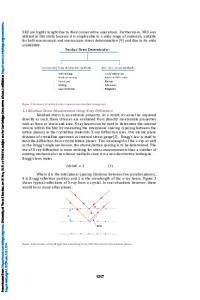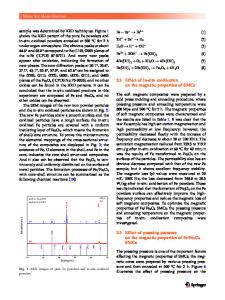Influence of deposition parameters on mechanical properties of sputter-deposited Cr 2 O 3 thin films
- PDF / 648,081 Bytes
- 7 Pages / 612 x 792 pts (letter) Page_size
- 15 Downloads / 351 Views
MATERIALS RESEARCH
Welcome
Comments
Help
Influence of deposition parameters on mechanical properties of sputter-deposited Cr2O3 thin films P. Hones and F. Le´vy EPFL-Institut de physique applique´e, Ecole Polytechnique Fe´de´rale de Lausanne, CH-1015 Lausanne, Switzerland
N.X. Randall CSEM Instruments, Jaquet-Droz 1, CH-2007 Neuchaˆtel, Switzerland
Among the oxides, Cr2O3 exhibits the highest hardness value and a low coefficient of friction. These properties make chromium oxide an excellent coating material for tribological applications. Cr2O3 thin films were deposited by radio-frequency reactive magnetron sputtering at substrate temperature in the range 363–593 K. The hardness and elastic modulus of the films were measured by two complementary nanoindentation techniques to investigate the influences of the substrate temperature and the oxygen content in the sputtering gas. While the continuous stiffness data method provides information throughout the whole film thickness, nanoindentation combined with scanning force microscopy of the residual imprints allows visualization of pileup, cracking, and delamination from the substrate. Hardness values up to 32 GPa were obtained for substrate temperatures exceeding 500 K and oxygen contents between 15% and 25% of the total gas pressure. The films, obtained with these deposition conditions, showed good adhesion to silicon substrates.
I. INTRODUCTION
It has been established that Cr2O3 is among the hardest oxides both in the mineralogical (8.5 Mohs) and in the microhardness scales (29.5 GPa).1 However, recent research work has concentrated mostly on Al2O3, which is used in tribological and microelectronic applications as a barrier layer, due to its chemical and thermodynamical stability. Comparatively few publications are dedicated to chromium oxide and its mechanical properties. Cr2O3 films have been deposited by sputtering, chemical vapor deposition (CVD) and plasma spray pyrolysis. Studies report a good wear resistance and a low coefficient of friction,2 however hardness values well below the bulk value. Recently, Bhushan et al.3 measured a hardness value of 29.5 GPa for a 200-nm-thick oxygen deficient film. The major drawback compared to the generally softer transition metal nitrides, which are nowadays standard in the industry of wear protective coatings, is the usually lower toughness and transverse rupture strength of the oxide coatings.4 Nevertheless, Cr2O3 coatings have already found several applications e.g. as protective coatings on read-write heads in digital magnetic recording units5 or in gas-bearing applications.3 The present study investigates the influence of deposition parameters, namely the substrate temperature and the oxygen content in the sputtering gas, on the mechanical properties of Cr2O3 thin films. In order to obtain not only accurate hardness and modulus values, but also information on the deformation mechanism, two complementary nanoindentation techniques have been used, J. Mater. Res., Vol. 14, No. 9, Sep 1999
http://journals.cambridge.
Data Loading...











